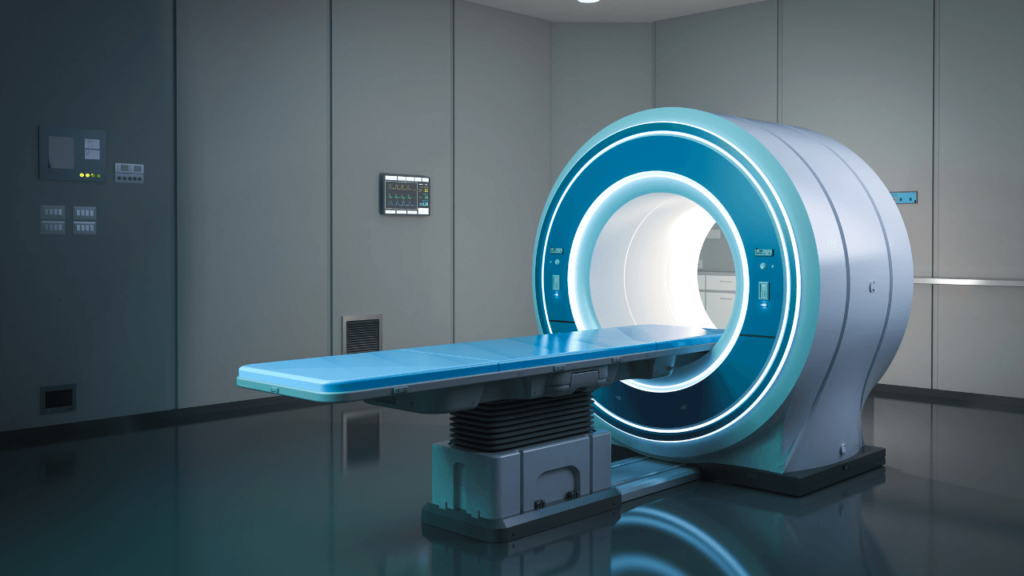If you’re like most people, getting an MRI can be nerve-wracking. You might wonder what clothing you’re allowed to wear during the procedure. Well, here’s a question you might not have anticipated: Can you wear a menstrual pad during an MRI? It’s a valid concern, as the idea of having to remove one’s pad mid-procedure can be both embarrassing and impractical. Fortunately, the answer is it depends. While most pads are made of materials that don’t pose a risk for MRI-related issues, it’s best to check with your doctor to ensure you’re wearing the most compatible type of pad for your MRI. This article will explore the reasoning behind this precaution and suggest helpful tips to make your MRI experience as comfortable as possible.
What is an MRI Scan?
An MRI scan is a medical imaging procedure that uses a strong magnetic field, radio waves, and a computer to create detailed images of internal body structures. This non-invasive technique is commonly used to diagnose various medical conditions, from brain tumors to musculoskeletal disorders. But many women may wonder – can you wear a menstrual pad during an MRI? It’s a valid question that many may feel too embarrassed to ask, but the answer is yes – it’s perfectly safe to wear a pad during an MRI scan. The magnetic field used during the procedure will not affect the pad or cause any harm to the body, so you can feel comfortable and confident during your MRI appointment.
Benefits of an MRI Scan
1. Noninvasive and Painless:
MRI scans are noninvasive, meaning they require no surgery or incisions. The procedure is painless and does not involve X-rays, meaning the patient is not exposed to radiation. Unlike some older technologies, which can be uncomfortable and sometimes painful, an MRI scan allows a patient to relax and is noninvasive.
2. Early Detection of Medical Issues:
One of the most significant benefits of an MRI scan is the early detection of medical issues. MRI scans can detect and diagnose a wide range of health problems, from internal bleeding to abnormalities in the brain. Early detection of such diseases allows treatment to start immediately, giving patients the best chance of fully recovering.
3. Detailed Imaging:
MRI scans provide detailed images of internal organs, soft tissues, and bones, making it easier for doctors to see what is happening inside the body. These images are incredibly useful for diagnosing medical issues such as cancer, tumors, and other abnormalities that are too small to be seen with other imaging technology.
4. Accurate Diagnosis:
MRI scans are incredibly accurate and reliable. With an accuracy rate of over 90%, they are one of the most precise diagnostic tools available, providing doctors with a clear and accurate picture of any medical issues that may be present in the body. This accuracy ensures that doctors are given the information they need to make informed decisions about the best possible course of treatment.
5. Customized for Each Patient:
MRI scans can be customized to fit the unique needs of each patient. Doctors can use contrast agents to highlight specific body areas, allowing them to look at certain tissues or organs better. This customization ensures that each patient’s needs are met and each scan is as informative and helpful as possible.
What Are Signs and Symptoms Can Accompany PVAD During MRI?
Peripheral vascular artery disease (PVAD) is a condition that can lead to restricted blood flow in the arteries of the limbs. This can cause pain, numbness, and weakness in the affected limbs. PVAD can also cause problems with wound healing and an increased risk of infection.
MRI can be used to help diagnose PVAD.
The test can show artery narrowing or blockage and any areas of damage or inflammation. MRI can also help rule out other conditions that may cause similar symptoms.
If you have PVAD, you may experience one or more of the following symptoms:
- Pain in the legs or feet when walking or during other activities
- Cramping in the legs or feet at night
- Numbness or weakness in the legs or feet
- Coldness in the legs or feet
- Skin changes, such as ulcers or gangrene
- Difficulty healing wounds
- Infections in the legs or feet
If you have any of these symptoms, could you talk to your doctor? They will ask about your medical history and perform a physical exam. You may also need tests, such as an MRI, to confirm the diagnosis.
If PVAD is causing symptoms, treatment will focus on relieving those symptoms. This may include lifestyle changes, such as quitting smoking and exercising regularly. You may also need medication to improve blood flow or surgery to bypass the blocked arteries.
PVAD is a severe condition that can lead to serious complications. However, with early diagnosis and treatment, many people with PVAD can live normal, healthy lives.
Can You Wear A Menstrual Pad During An Mri?
It’s generally advised to avoid wearing metal objects during an MRI scan, including jewelry, watches, and clothing with metal parts. The presence of metal can interfere with the magnetic field generated by the MRI machine, potentially distorting the images and affecting the scan’s accuracy.
1) Metal Components in Sanitary Pads
Sanitary pads often contain metal components, such as adhesive strips, which can interfere with the MRI. These metal elements are susceptible to the strong magnetic field of the MRI machine, leading to potential movement of the pad and subsequent distortion of the scan images. This movement can compromise the quality of the diagnostic images, making accurate interpretation difficult.
2) Communicating with Healthcare Providers
If you need to wear a sanitary pad before an MRI, it is essential to inform your healthcare provider. They will provide specific guidance on whether you need to remove the pad before the scan and offer alternative solutions. Communication with your healthcare team ensures that they can make appropriate accommodations for your comfort and the accuracy of the scan.
3) Alternative Feminine Hygiene Options
To address these concerns, your healthcare provider might suggest alternative feminine hygiene options or provide a disposable hospital gown to mitigate any risk posed by the sanitary pad. These precautions help maintain the integrity of the MRI scan, ensuring the best possible diagnostic outcomes.
Why Avoid Sanitary Pads During an MRI
Sanitary pads are typically constructed with layers of materials that may include small metal parts, such as adhesive strips or micro-wires used to keep the pad in place. These metal components can significantly interfere with MRI scans. The powerful magnetic field generated during the MRI process can cause these metal parts to move or heat up, potentially leading to discomfort or even injury for the patient.
Additionally, when these metal elements interact with the magnetic field, they can produce artifacts or distortions in the images captured by the MRI machine. These distortions can obscure vital anatomical details, leading to inaccurate diagnoses or complicating the identification of medical conditions. Consequently, such interference may result in the need for repeated scans, thus delaying treatment and increasing overall healthcare costs. For these reasons, it’s crucial to either avoid wearing sanitary pads during an MRI or seek guidance from healthcare providers for alternative solutions.
Alternatives to Menstrual Pad During An Mri?
There are several options to use during an MRI instead of sanitary pads. Ensuring that the alternative chosen does not contain metal components is crucial to maintaining the integrity of the MRI images and patient comfort. Here are some detailed alternatives:
Disposable Hospital Underwear or Gowns
- Medical Design: Disposable hospital underwear and gowns are specifically designed for medical procedures, including MRI scans.
- No Metal Components: These garments are free of any metal parts that could interfere with the MRI.
- Comfort and Hygiene: They provide comfort and adequate hygiene, ensuring that the patient undergoes the procedure without any issues related to their period.
Tampons
- Metal-Free: Tampons do not contain metal components, making them safe for use during an MRI.
- Variety: Available in various absorbency levels to suit individual needs during the MRI scan.
- Convenience: Easy to use and does not need to be changed as frequently as some other options.
Menstrual Cups
- Reusable: Menstrual cups are reusable, eco-friendly options without any metal parts.
- Long-Lasting: Can be worn for up to 12 hours, providing extended protection during lengthy procedures.
- Secure Fit: Ensures a secure fit, reducing the risk of leakage and providing comfort throughout the MRI scan.
Menstrual Discs
- Flexible Fit: Menstrual discs are designed to fit comfortably with no metal components.
- Extended Use: Can be worn for up to 12 hours, similar to menstrual cups.
- Less Invasive: Generally sits higher in the vaginal canal, providing a discreet and comfortable option during an MRI scan.
FAQs
Can You See A Pad In An MRI?
Yes, you can see a sanitary pad in an MRI. However, I would like to point out that not all types of sanitary pads can be seen in an MRI. For example, pads that are made of metal or have metal in them will not show up in an MRI.
Do Periods Affect Mri Scan?
You don’t need to worry about your period affecting your MRI scan. You can rest assured that the team performing your scan will take all necessary precautions to ensure that your period doesn’t affect the quality of the images.
Does Menstruation Affect Pelvic MRI?
There is no definitive answer to this question, as each person experiences menstruation differently and has a different body type. However, it is generally accepted that menstruation can affect pelvic MRI results in a few ways.
- First, blood in the uterus can make it difficult to see the pelvic organs.
- Second, the uterus may be enlarged during menstruation, making it difficult to see the pelvic organs.
- Finally, some women experience cramping and pain during menstruation, making it difficult to stay still during the MRI exam.
What Should You Not Wear During An MRI?
You should not wear anything with metal during an MRI. This includes clothing with zippers, snaps, or buttons made of metal and jewelry. Metal can cause artifacts in the MRI images. You should remove any hair clips, barrettes, or other metal accessories.
What Happens If You Wear Metal In An MRI?
If you wear metal in an MRI machine, it can cause several problems.
- First, the metal can distort the magnetic field, making the MRI machine’s images less accurate.
- Additionally, the metal can cause the machine to produce more noise, which can be extremely loud and disruptive.
- Finally, the metal can heat up during the MRI, which can cause burns.
What Happens If You Wear A Ring During An MRI?
If you wear a ring during an MRI, it could become magnetized. This could cause the ring to move during the MRI and potentially cause injury to you or the person operating the MRI machine.
Do you wear a bra during an MRI?
Yes, you should wear a bra during an MRI. You don’t need to remove your bra for the exam, but you may be asked to remove other clothing and jewelry before the exam.
However, MRIs are important in diagnosing and treating many medical conditions. To get the most accurate MRI, it is important to wear comfortable, loose-fitting clothing with no metal fasteners.
Conclusion
To sum it up, the answer to the burning question, can you wear a menstrual pad during an MRI? is a resounding no. While it may seem logical to keep it on for comfort, the reality is that menstruation pads are not only made of materials that could interfere with the MRI imaging process but may also cause unnecessary discomfort to the patient. It’s always best to follow your doctor or radiologist’s instructions when preparing for an MRI scan, including not wearing metallic objects or clothing and informing them of any medical conditions or implants. With that said, it’s important to remember that it’s normal to feel apprehensive about the unknown, but with the right information and guidance, you can get through any medical procedure without undue stress or anxiety.


